15. Attracting Visitors to Your Blog
Objective: To promote your blog and attract visitors.
You’ve created a blog. You’ve posted to your blog. Now all you need are some visitors to read your posts.
How do you make people aware of your blog? Fortunately, there are lots of ways to promote your blog—something for every budget, from no cost to big bucks. Read on to learn more.
Configuring Your Blog to Be More Noticed
The first thing you need to do is to take advantage of all the tools and settings within Blogger itself to make your blog more noticeable. These are little things, free things, that anyone can and should do to help put their blog on the radar-scope.
Get Listed in Blog Directories and Search Engines
Many people find new blogs to read by browsing or searching the various blog directories on the Web. To that end, you want to get your blog listed in as many of these directories as possible.
Show Me: Media 15.1—How to Configure Blogger for More Visibility

To learn how to add your blog to blog directories, see the video titled “How to Configure Blogger for More Visibility” on the companion Using website, my.safaribooksonline.com/9780132119603/media.
Adding Your Blog to Blogger’s Listings
Perhaps the most important blog directory for Blogger users is the Blogger directory. Listed blogs show up in the Blogs of Note section of the Dashboard page, get linked to when users click the Next Blog button on the Blogger NavBar, and appear elsewhere in Blogger.
To this end, you want to make sure that your blog is added to Blogger’s listing. Here’s how to do it:
- From the Blogger Dashboard, click the Settings link next to your blog name.
- When the Settings tab appears, click the Basic subtab.
- Scroll to the Add Your Blog to Our Listings? section, shown in Figure 15.1, and select Yes from the pull-down list.
Figure 15.1. Two ways to make your blog more visible.

 LET ME TRY IT
LET ME TRY IT
Letting Search Engines Find Your Blog
For heightened visibility, you want your blog to be searched from Google Blog Search and other search engines. You also want your blog to appear on the “recently updated” lists published by various blog-related services.
To enable this type of visibility, follow these steps:
- From the Blogger Dashboard, click the Settings link next to your blog name.
- When the Settings tab appears, click the Basic subtab.
- Scroll to the Let Search Engines Find Your Blog? section (see Figure 15.1) and select Yes from the pull-down list.
Get Current Visitors to Read More
A good blog will build a community of loyal readers. To make it easier for readers to know when you post, you should activate a site feed for your blog. This way readers can subscribe to your feed with their favorite feed readers or custom-content home pages and automatically be notified when there’s a new post on your blog, making it more likely for them to actually read your blog posts.
 LET ME TRY IT
LET ME TRY IT
Activating Your Site Feed
To activate your site feed, follow these steps:
- From the Blogger Dashboard, click the Settings link next to your blog name.
- When the Settings tab appears, click the Site Feed subtab.
- To syndicate the full content of each post, pull down the Allow Blog Feeds list and select Full. To syndicate just the first paragraph (or 255 characters) of each post, select Short. If you don’t want to activate a feed, select None.
- Click the Save Settings button.
 LET ME TRY IT
LET ME TRY IT
Enabling Following
Following is a relatively new feature that helps visitors keep updated on the latest activity on your blog. When someone becomes a follower of your blog, your blog is listed in that person’s reading list on their Blogger Dashboard page, as shown in Figure 15.2. In addition, the follower’s name is displayed in the Followers gadget on your blog; over time, a popular blog can build up quite a list of followers.
Figure 15.2. Followed blogs are listed in the Reading List section of the Dashboard.

To enable following, you have to add a Followers gadget to your blog’s sidebar, as follows:
- From the Blogger Dashboard, click the Layout link next to your blog name.
- When the Layout tab appears, select the Page Elements subtab.
- From the Page Elements subtab, click the Add a Gadget link at the top of the sidebar.
- When the Add a Gadget window appears, click the + next to the Followers item.
- When the Configure Followers List window appears, as shown in Figure 15.3, enter a title for this gadget.
Figure 15.3. Adding a Followers gadget to your blog.
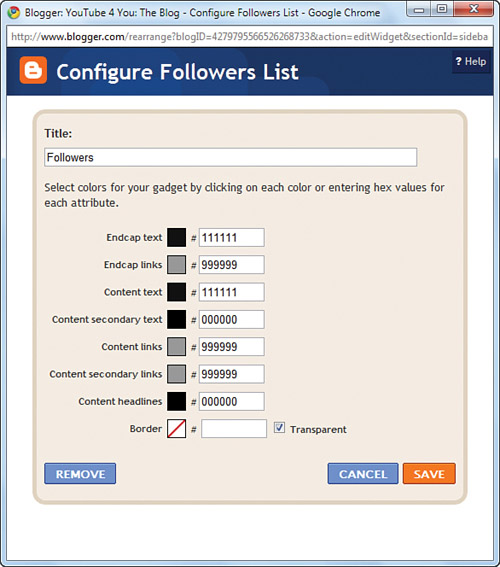
- To change colors in the gadget, select new colors for various items.
- Click the Save button.
- To move the gadget elsewhere in the sidebar, click and drag it with your mouse.
Visitors now see the Followers gadget in your sidebar, as shown in Figure 15.4. To become a follower, a user need only click the Follow button and follow the onscreen instructions.
Figure 15.4. A typical Followers gadget in a blog sidebar.
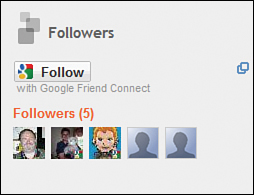
 LET ME TRY IT
LET ME TRY IT
Using the Email This Post Function
Finally, you can make it easy for regular site visitors to share their favorite posts with friends and colleagues by enabling Blogger’s Email This Post function.
When activated, Blogger displays an Email icon below each blog post; visitors need only click this icon to display the Email Post to a Friend page and send a message about this post.
To activate the Email This Post function, follow these steps:
- From the Blogger Dashboard, click the Settings link next to your blog name.
- When the Settings tab appears, click the Basic subtab.
- Scroll down to the Show Email Post Links? section and select Yes from the pull-down list.
Practice Best Blogging Practices
You can also maximize the visibility of your site by following what I call best blogging practices. That is, the better a blogger you are, the more traffic your blog will attract.
Tell Me More: Media 15.2—About Best Blogging Practices

To learn more best practices when it comes to blogging, listen to the audio clip titled “About Best Blogging Practices” on the companion Using website, my.safaribooksonline.com/9780132119603/media.
What exactly are best blogging practices? A lot of them are common sense, and involve how you blog. Here are some tips to consider:
• Create a focused blog—The most-viewed blogs are those that focus on a particular topic or target a particular type of user. If your blog content is all over the place, visitors won’t know what to expect and will gradually (or not-so-gradually) drift away. Focus on a particular topic and you’ll get people who are interested in that topic coming back to see what’s new. It’s all about cultivating an audience—and giving the audience what they expect.
• Create quality content—You have to give your readers some real meat. That means unique and uniquely valuable content, stuff they won’t find elsewhere. The more valuable your content is, the more visitors you’ll attract—and the more other people they’ll tell about what they find.
• Write well—The better a writer you are, the more repeat visitors you’ll attract. Whether they know it or not, people like good writing. That means good grammar and punctuation, as well as a unique voice or writing style.
• Be concise—The best posts are those that are short and to the point. Most people don’t expect or want to read article-length posts on the Web; they want their information and opinion presented in bite-size chunks. So keep your posts short; don’t pad them with unnecessary fluff.
• Post often—You want your blog to be fresh, and for visitors to always find something new when they visit. That means posting frequently and regularly. (This also helps populate your blog feed, which is another way to keep visitors coming back for more.)
• Link to other blogs—Many people discover new blogs by linking from blogs they currently like. You need to participate in this process, which means linking to other blogs from within your posts and installing a Blog List gadget in your blog’s sidebar, like the one shown in Figure 15.5. You can add a Blog List gadget to your blog by opening your blog’s Layout tab, selecting the Page Elements subtab, clicking the Add a Gadget link, and then selecting the Blog List gadget. Enter the URLs of your favorite blogs, and Blogger will keep your blog list updated with the latest posts from these blogs.
Figure 15.5. A list of favorite blogs in a Blog List gadget.
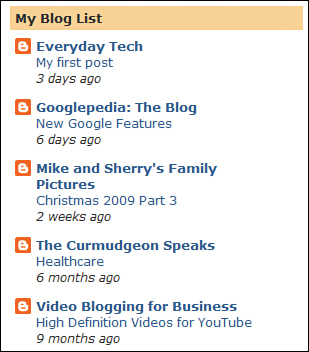
• Encourage other blogs to link to yours—If you link to other blogs from yours, it would be nice if they returned the favor. You should encourage other bloggers to include your blog in their blog lists, and to link to your blog in appropriate posts. This probably means contacting other bloggers via email; this sort of communication is a good thing.
• Be an active commenter—If you want your blog to show up on other bloggers’ blog lists, you need to make yourself known to those bloggers. The best way to do this is to frequently and intelligently comment on posts to your favorite blogs. Become an active member of the blogosphere and your participation will be rewarded.
Optimizing Your Blog for Search Engines and Directories
Earlier in this chapter I mentioned the importance of making sure your blog is visible to Google Blog Search and other search engines. If you want your blog to rank high in these search engines’ search results, you need to optimize your blog for these search engines. The higher your blog ranks in the search results, the more traffic you’ll generate from searches.
To achieve a higher search ranking, you need to employ search engine optimization (SEO) techniques, the same as you’d use on a freestanding website. It’s all about matching your blog’s content with the keywords that users are searching for.
With that in mind, here are some of the more effective SEO techniques you should employ in your blog.
Tell Me More: Media 15.3—About Optimizing Your Blog for Search

To learn more about optimizing your blog for search engine visibility, listen to the audio clip titled “About Optimizing Your Blog for Search” on the companion Using website, my.safaribooksonline.com/9780132119603/media.
Optimizing Your Blog Template
The first thing to pay attention to is your blog’s template, which defines how blog posts are displayed. The template contains the content that surrounds the blog posts themselves—the blog title and description, as well as everything displayed in the blog’s sidebar.
Probably the most important thing to keep in mind when optimizing your blog template are keywords—those words and phrases that people use when searching with Google, Yahoo!, and the other search engines. Search engines look for these keywords when they’re indexing blogs and other web pages; the more prominent and relevant the keywords in your blog, the higher your blog will appear in the search engines’ results.
Start by deciding on the keywords and phrases that people are searching for and that best describe your blog’s content. Next, insert those keywords within your blog’s descriptive text—which, ideally, should appear high on your blog page, either directly underneath the name of the blog or at the top of your blog’s sidebar. You should also place important keywords in the template’s <TITLE> tag, <META> tags, and all alternative image text—which means editing your template’s HTML as necessary.
Optimizing Blog Posts
You can also optimize each post on your blog. Here you use traditional SEO techniques.
Start by including your most important keywords in the title of each blog post. This is even more important than with traditional websites, since many content syndicators and aggregators list only the title of a post. Because only the title is seen in most feed reader applications, this makes the title much more important than the main text of a post.
Next, focus on the content of each post. Again, it’s important to weave keywords and phrases into the post text, especially in the first paragraph of longer posts. Remember, the first few sentences of a blog post are what people see when your post is listed on a search engine’s results page.
You should also liberally apply labels or tags to each of your posts. These tags are one of the ways that readers find content on your blog, but they’re also useful to searchbots trying to determine your blog’s content. Assign each keyword or phrase a separate label; since these labels are internal links to your post, that increases the number of links, which is always a good thing.
Finally, you should turn on Blogger’s post pages feature. This publishes every post as its own web page, which ensures that your posts are more linkable and thus more attractive to search engines.
 LET ME TRY IT
LET ME TRY IT
Turning on Post Pages
To enable Blogger’s post pages function, follow these steps:
- From the Blogger Dashboard, click the Settings link next to your blog name.
- When the Settings tab appears, click the Archiving subtab.
- Scroll down to the Enable Post Pages? section and select Yes from the pull-down list.
Submitting Your Blog to the Major Search Engines
Optimizing your blog for search is important, but so is submitting your blogs to the major search engines. If a search engine doesn’t know your blog exists, all the optimization in the world doesn’t matter.
To this end, it’s important to create a site feed for your blog. Google, Yahoo!, and Bing automatically index these feeds, with no further work required on your part.
To submit your site feed to the major search engines, you first need to know the URL of the feed. You can find this by clicking the Subscribe to Posts link at the bottom of your blog; the URL of the next page is your site feed URL. You then submit your blog to each of the search engines separately, as described next.
 LET ME TRY IT
LET ME TRY IT
Submitting to Yahoo!
To submit your blog to Yahoo!, follow these steps:
- Go to the Yahoo! Site Explorer page (http://siteexplorer.search.yahoo.com/submit/).
- Click the Submit Site Feed link.
- When the page expands, as shown in Figure 15.6, enter the URL of your site feed into the box.
Figure 15.6. Submitting your site feed to Yahoo!
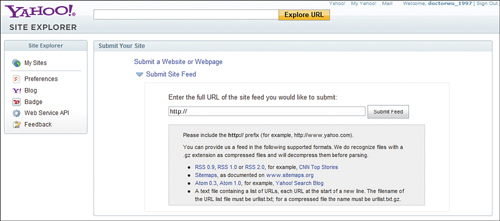
- Click the Submit Feed button.
Submitting to Bing
To submit your blog to Microsoft’s Bing search engine, follow these steps:
- Go to the Submit Your Site to Bing page (www.bing.com/webmaster/SubmitSitePage.aspx), shown in Figure 15.7.
Figure 15.7. Submitting your site feed to Bing.
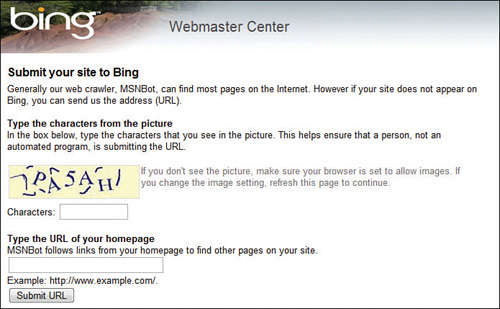
- Enter the URL for your site feed into the Type the URL of Your Homepage box.
- Enter the secret characters into the word verification box.
- Click the Submit URL button.
Submit to Other Blog Directories
In addition to submitting your site feed to the major search engines, it’s also a good idea to submit to the various blog and RSS directories available on the Web. There are a slew of them, and each has its own submittal process. You should consult with each directory individually to determine how to submit your blog.
Here are some of the more popular blog directories you should consider submitting to:
• Best of the Web Blogs Search (http://blogs.botw.org)
• Bigger Blogger (www.biggerblogger.com)
• Blog Flux (www.blogflux.com)
• Blog Listing (www.bloglisting.net)
• Blog Search Engine (www.blogsearchengine.com)
• Blog Universe (www.bloguniverse.com)
• BlogCatalog (www.blogcatalog.com)
• Bloggapedia (www.bloggapedia.com)
• Blogged (www.blogged.com)
• Bloggeries (www.bloggeries.com)
• Bloggernity (www.bloggernity.com)
• Blogging Fusion (www.bloggingfusion.com)
• Chordata (www.chordata.info)
• EatonWeb Blog Directory (http://portal.eatonweb.com)
• Feedage (www.feedage.com)
• FeedFury (www.feedfury.com)
• FeedOoyoo (http://feedooyoo.blogspirit.com)
• FeedPlex (www.feedplex.com)
• Feeds4All (www.feeds4all.nl)
• Globe of Blogs (www.globeofblogs.com)
• Go Blogz (www.goblogz.com)
• Jordo Media (www.jordomedia.com)
• OnTopList (www.ontoplist.com)
• Plazoo (www.plazoo.com)
• Postami (http://blogdirectory.postami.com)
• RSS Locator (www.rss-locator.com)
• RSS Network (www.rss-network.com)
• RssFeedDirectory (www.rssfeeddirectory.org)
• RSSMotron (www.rssmotron.com)
• Search4RSS (www.search4rss.com)
• SpillBean (www.spillbean.com)
• Syndic8 (www.syndic8.com)
Advertising Your Blog with Google AdWords
All the advice given so far in this chapter doesn’t cost you one red cent; you can apply any or all of those tips for free.
There is, however, another way to promote your blog that will cost you some bucks. I’m talking about advertising, via Google’s AdWords program.
Tell Me More: Media 15.4—About Google AdWords

To learn more about Google AdWords, listen to the audio clip titled “About Google AdWords” on the companion Using website, my.safaribooksonline.com/9780132119603/media.
Google AdWords is the flip side of the AdSense program discussed in Chapter 14, “Making Money from Your Blog.” You use the AdWords program to buy pay-per-click (PPC) ads that promote your blog; when visitors click on the ad, they go directly to your blog—and you pay for that click.
Show Me: Media 15.5—How to Create an AdWords Campaign and Ad

To learn how to create an AdWords campaign, see the video titled “How to Create an AdWords Campaign and Ad” on the companion Using website, my.safaribooksonline.com/9780132119603/media.
How AdWords Works
You sign up for Google AdWords at http://adwords.google.com. Once you’ve signed up, you then establish a daily advertising budget and start creating your ad campaigns and individual ads.
AdWords lets you create small text ads, like those shown in Figure 15.8. Each ad has a short title, two lines of descriptive text, and the URL of your blog. You link the entire ad to your blog’s URL; when a user clicks the ad, they’re taken to your blog.
Figure 15.8. A typical block of AdWords text ads.

The ads you create get placed on Google’s search results pages, throughout Google’s entire network of sites (Gmail, Google Maps, YouTube, and so forth), and on websites and blogs that belong to the AdSense network. Google claims that its AdWords program reaches more than 80 percent of all Internet users; most advertisers confirm that AdWords generates the overwhelming majority of PPC traffic to their sites.
Because they’re pay-per-click ads, you pay only when a user clicks your ad; you don’t pay for display. You control your costs by specifying how much you’re willing to pay per click, and by setting a daily spending budget. Google will never exceed the costs you specify.
The way it works is that you bid on one or more keywords—that is, you specify the maximum amount you’re willing to pay for that keyword. Google employs its AdWords Discounter technology to match the price you pay with the price competing advertisers are offering for a given keyword. This is, in effect, Google’s automated bidding system. The AdWords Discounter automatically monitors your competition and lowers your cost per click (CPC) to 1 cent above what they’re willing to pay.
Google then places your ad on relevant blogs and web pages, based on your keyword bid amount, until your budget runs out. At that point your ad is withdrawn from circulation until the next budget period begins, or until you increase your budget.
You can opt to continue to run a given ad indefinitely, or to run an ad for a limited period of time only. You can run multiple ads simultaneously, if you wish, or go with a single ad. You can even create separate ads for different keywords; the more sophisticated your approach, the better your potential results.
Budgeting for AdWords
How much does AdWords cost? It’s your choice. You can choose a maximum CPC price from $0.01 to $100. Your daily budget can be as low as a penny, up to whatever you’re willing to pay.
At the end of each month, AdWords bills you for the number of clicks on your ads. If no one clicked, you don’t pay anything—but then again, you can hardly call that a success. You only get billed, of course, up to the maximum amount of your budget. If the cost of those clicks are under your budget number, you only pay for the actual clicks, not the maximum amount you budgeted.
There isn’t space here to go into all the details of AdWords advertising. Suffice to say, if you want to drive new visitors to your blog, advertising for those visitors can be quite effective. It can also, of course, be quite expensive. You have to decide how much new visitors are worth to you, and budget accordingly.
